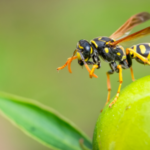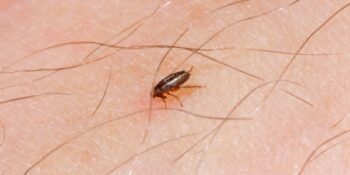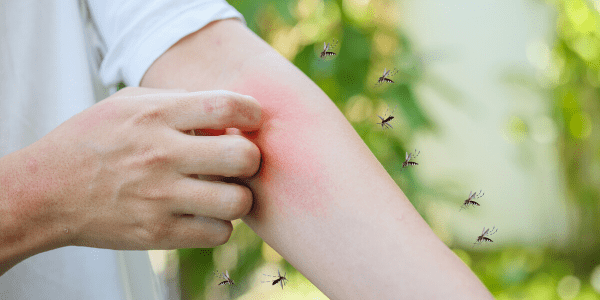
Whether you’re enjoying a day at the beach, camping with your family, or spending time at home in your backyard, dealing with bug bites is inevitable during the summer on Long Island. Annoying as bites and stings may be, most of the time they just cause a bit of temporary discomfort. Some reactions can actually be more severe, depending on the insect and your body’s reaction to it. If you’re dealing with an insect bite right now and wondering what bit you, keep reading to learn some easy ways for identifying bug bites, how to treat bug bites, and how to help prevent future unwanted insect encounters.
Ant Bites
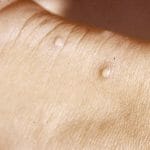
When it comes to ant bites, reactions are usually caused by an ant’s initial sting and the injection of its venom into your skin. Common black ant bites that you get from the odorous house ants that pop up in your kitchen from time to time are fairly mild, with some redness, swelling, and moderate pain. Reaction to an ant bite varies from person to person, depending on the age of the person stung, the number of stings, and any underlying allergies. In the most serious cases, anaphylaxis, which is life-threatening, can occur.
Fire ant bites, compared to odorous house ant bites, are more severe. Fire ant stings cause red welts or lumps in semi-circular patterns which later become blisters. Fire ant stings burn, itch, and may last up to a week. Severe allergic reactions can occur, including swelling and breathing difficulties.
Bed Bug Bites
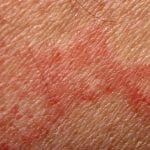
Bed bugs are sneaky nighttime biters, and their bites often go unnoticed. Bed bug bites appear as small, flat welts, often with swelling, and can appear in straight lines or clusters.
Bed bug bites can occur anywhere on your body, but most often will show up on uncovered areas like your neck, face, arms, and hands. The bites are generally mild, and easily confused with mosquito and flea bites. Bed bug bites have an initial burning sensation, followed by itching, and can result in mild or severe allergic reactions.
Bee Stings
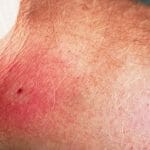
Bee stings result in sharp initial pain, followed by a more dull, aching feeling that remains sore for several days.
A red bump with white around it may pop up around the site of the sting, and the area may feel warm and itchy. For some people, bee stings result in more mild symptoms, but it’s not uncommon for much more severe reactions to occur, including anaphylaxis (which is life-threatening), hives, swelling, difficulty breathing, nausea, diarrhea, dizziness, and even cardiac arrest.
Flea Bites
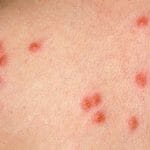
Flea bite symptoms usually show up within a few hours, in the form of small, red bumps which may appear in groups of three or four. Flea bites usually will show up on your arms and legs, but other areas like your waist, knees, elbows, and armpits are also fair game for these pests. Flea bites result in itching, hives, and swelling, with reactions that are rarely severe.
Mite Bites
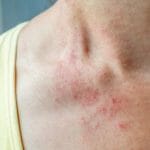
Mite bites, like bed bug bites, often go unnoticed at first. They irritate the skin and cause intense itching, causing red marks to develop that look similar to a skin rash. Chiggers are a specific type of mite which causes the skin around their bites to harden, becoming irritated and inflamed. In more serious cases, mites can cause scabies, which is a contagious condition resulting in a skin rash that looks like acne, and intense itching that gets worse at night.
Mosquito Bites
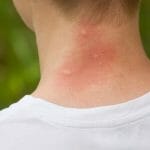
Mosquito bites can be found anywhere on the body, most often on exposed skin. They can appear within minutes as any of the following: puffy, white or red bumps; hard, reddish-brown bumps that itch; or as small blisters or dark spots that look bruised. Mosquito bites result in mild to moderate itching, swelling, and sometimes a low-grade fever. In severe cases, mosquitoes will transmit deadly diseases such as Zika, West Nile Virus, dengue fever, malaria, and other illnesses.
Spider Bites
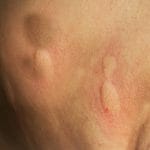
The appearance and severity of spider bites depends largely on the type of spider. Common house spider bites appear as two puncture marks close together, and can be found anywhere on the body. For many types, a red, swollen area will appear hours to days after a bite. Spider bite symptoms are typically mild, with redness, swelling, and manageable pain.
Certain spider bites are emergencies. For instance, the brown recluse spider bite, which typically feels about like a bee sting, but can develop into severe pain at the site of the bite about four hours. Brown recluse spiders are poisonous and cause serious reactions, including itching, nausea, fever, and muscle pain. Medical assistance should be sought immediately if you think you’ve been bitten by a brown recluse spider.
Scorpion Stings
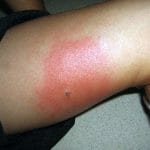
Most scorpion stings aren’t of great concern, but some can be lethal. Typical symptoms include pain, swelling, and itching at the site of the sting, and swelling and/or redness may not even be visible. In more severe cases, scorpion stings can result in numbness, difficulty swallowing, blurred vision, seizures, and difficulty breathing.
Tick Bites
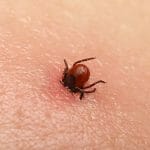
What does a tick bite look like? Well, the most obvious sign of a tick bite is a tick which is latched on or burrowed beneath the skin. Initial symptoms appear as redness around the bite area, itchiness, and/or a burning sensation. In serious cases, an expanding “bullseye” rash indicates Lyme Disease, which ticks are known to transmit, in addition to Rocky Mountain Spotted Fever, Babesiosis, and Tularemia, and several others.
How to Treat Bug Bites
Most insect bites and stings can be treated at home, especially if your reaction is mild. Remove any stingers in your skin, if applicable, wash the affected area, and apply an ice pack to reduce any pain or swelling. Topical anti-itch creams, antihistamines, and oral pain relievers may help alleviate uncomfortable symptoms.
Seek medical attention immediately if you’re experiencing a severe reaction including any of the following: fever, difficulty breathing, nausea, vomiting, muscle spasms, a rapid heartbeat, swelling of your lips and/or throat, confusion, or loss of consciousness.
How to Prevent Bug Bites
There are several precautions you can take to reduce your chances of getting bitten by insects:
- When you’re outside, avoid hives, nests, and aggressive insects as much as possible.
- Wear clothing that provides full coverage of your skin.
- Avoid perfumes and scented lotions.
- Keep your food and drinks covered.
- Avoid bright colors and/or floral patterns.
- The CDC recommends staying current on your tetanus booster shots and getting one every 10 years.
- Use insect repellents and/or citronella candles when you’re in the yard.
- Implement a regular pest control service.
Suburban Exterminating offers year-round pest protection to Long Island homeowners. We start by eliminating your existing pests and create a barrier around your house to keep future pests away. Take advantage of our pest-free* guarantee and eliminate insect bite concerns around your home, fill out our contact form!

